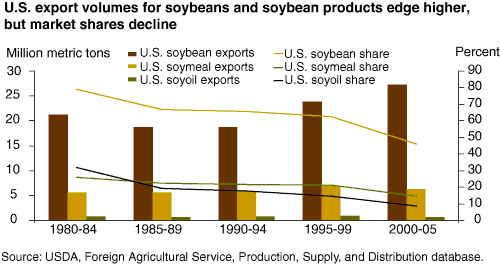International Trade, Biofuel Initiatives Reshaping the Soybean Sector
- by Mark Ash and Erik Dohlman
- 9/1/2006
Increased domestic and global demand over the past decade continues to pull U.S. soybean production steadily upward. Rising demand has prompted producers to shift acres from wheat to soybeans, capitalizing on the additional planting flexibility provided since the 1996 Farm Act. Expanding use of corn and soybeans for domestic biofuel production and global market trends are likely to influence the future direction of the soybean sector.
A key concern among U.S. soybean producers is export competitiveness. Trade has been constrained by slow import growth in traditionally strong markets for U.S. soybeans, such as the European Union (EU), and intensifying export competition from South American producers. Although as much as 40 percent of U.S. soybean production is exported, the U.S. share of the global soybean export market declined from 60 percent in crop year 1990 to 37 percent in crop year 2005. The main bright spot for domestic producers is soaring demand in China, which has now surpassed the EU as the world’s largest soybean import market.
With the recent escalation of energy prices, the development of renewable crop-based fuels is a front-burner issue. In 2005, the U.S. Energy Policy Act set a requirement for the annual use of 7.5 billion gallons of renewable fuels by 2012. The Federal Government also introduced a tax incentive for biodiesel production. Although ethanol derived from corn will fulfill a majority of the renewable fuels mandate, these policies will have both direct and indirect effects on the soybean sector. Rising demand for corn to produce ethanol will likely draw cropland away from soybeans, and soybean producers will be able to sustain production only by raising yields. However, producers throughout the highest yielding areas of the Corn Belt may be lengthening the period between soybean crops from every other season to once every 3 years. This practice may make it harder to sustain the long-term growth of average soybean yields as lower yielding regions begin to account for a greater proportion of total acreage. New crop diseases, such as soybean rust, also pose risks to yields.
While lower soybean acreage stemming from shifts to corn may dampen export competitiveness, it should support prices. The emerging demand for biodiesel may also help buoy prices, since U.S.-produced biodiesel is derived primarily from soybean oil. However, many infrastructure and logistical issues remain before biodiesel fuel use becomes widespread in the United States
This article is drawn from:
- Ash, M., Livezey, J. & Dohlman, E. (2006). Soybean Backgrounder. U.S. Department of Agriculture, Economic Research Service. OCS-200601.
You may also like:
- U.S. Agricultural Trade. (n.d.). U.S. Department of Agriculture, Economic Research Service.
- Corn and Other Feed Grains. (n.d.). U.S. Department of Agriculture, Economic Research Service.
- Soybeans and Oil Crops. (n.d.). U.S. Department of Agriculture, Economic Research Service.


